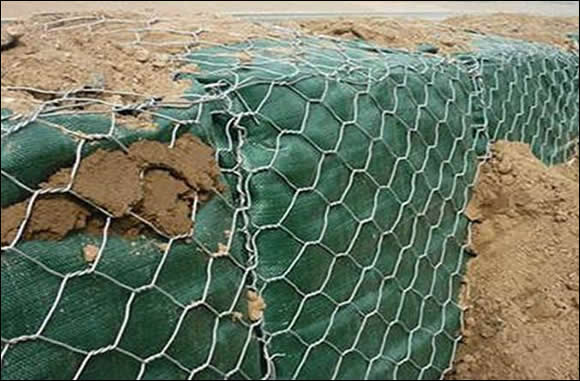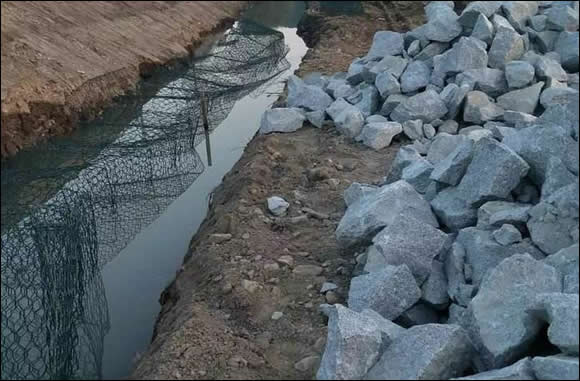Gabions Products
- Military Gabions

- Hot Dipped Galvanized Gabion Mesh Cells

- Welded Mesh Gabions Architectural Wall Cladding

- Gabions (Gabiony)
- Galfan + PVC Coated Gabions
- Gabion Mattresses for Flood Protection Embankment
- Planted Gabion Walls

- Gabions and Geotextiles for Bridge Construction
- Gabion Basket Hot Dip Galvanized
- Gabions P. V. C. Coated Galvanised Wire Box
- Gabions River Training Works
- Geotextile Fabric
- Woven Wire Mesh Cages for Gabion Project
- Gabion Fence
- Welded Gabions Coating Galfan
- Gabion Baskets Double Twisted Galvanized
- Triple Twisted Wire Mesh Gabions
- Gabion Box
- Woven Gabions
- Gabion Baskets
- Wire Mesh Gabion Mattress
- Gabion Cages (Stone Box)
- Gabion Wall
- Hexagonal Gabions Netting
- Gabions Machine
- Welded Gabions
- Sack Gabions
- Reinforced Gabions
- Gabion faced reinforced soil walls
- Gabion Mattress
- Gabions for Water Conservancy
- Gabions for Bridge Protection System
- Gabion Wall Drop Structures
- Modular Gabions as Architectural Elements
- Gravity Wall of Gabions
- Gabions for Headwalls or Wingwalls
- Channel Linings
- Modular Gabions for Rockfall Netting System
Gabions Applied in Water Conservancy Project and River Engineering
The gabion box (box shaped stone cage) is constructed by large-size hexagonal wire netting, and the stones are placed in the cage and sealed during construction. It can be produced according to customer requirements, and the surface protection treatments include hot-dip galvanized, zinc aluminum galfan coated, PVC coated, etc.

The structure can be used for side slope support, nets on mountain rock surface, side slope vegetation (greening), and isolation barriers for railways and highways. It can also be made into cages and net mats, which are used for anti-scouring protection of rivers, dams and seawalls, and net cages for the closure of reservoirs and rivers.
In large-scale water conservancy projects, the selected stones should be strong and durable, have a certain density, and have a diameter of 4 inches to 8 inches. Large stones are easier to install than round and coarse ones. The filled stones should minimize the gaps between the materials. The exposed surface should use a larger volume of stones to avoid flowing out of the holes. Use fine stones to fill the gaps and densely, and then continue to load. Stone materials should meet certain standards, with a float of +/-5%. In addition, special attention is paid to protecting gabions by PVC coating so that the gabion boxes can be used in water conservancy projects to maintain the alkali and corrosion resistance of the gabion net.

In water conservancy projects, the application of gabions makes a very economical solution. The gabions system is composed of steel wire cages and natrual filling materials, and the cost is lower than that of general construction materials. The filling material shall be resistant to weathering and has a certain strength, usually stones of different grades at the engineering site can be used as fillers, and sometimes even some cleaner construction waste can be used as fillers, so the cost is lower. Especially in the construction of protection projects in areas with poor soil foundation, the use of gabion net structure can avoid the trouble of foundation treatment, thereby saving the foundation cost which accounts for a large proportion of the project cost.
Stone gabions are popularly used for water control and conservancy projects.
The development and control of the river-ways concerns the technology of laying protective layer, with permanent protective function. The stone gabions can control water flowing volume and protect water resource from running off in holding the neighboring water resource and protecting and controlling the flood.
Main Characteristics of River Bank and Water Conservancy System Composed with Gabions:
1. General evolution of watercoursesl approach
2. Bioengineering
3. Gabion gravity structures
4. Strengthening the stability of the river beds
5. Protecting riverbeds soils from being washed away
6. Providing the prefixed value of coarseness modulus of river banks
